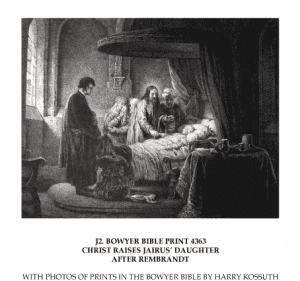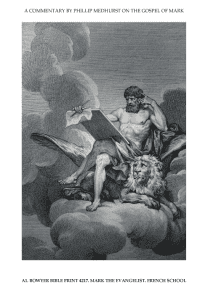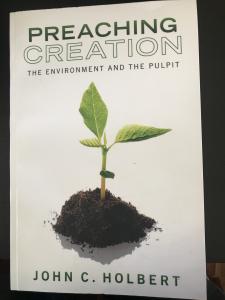 Mark 5 presents to us two of the more famous healings in Mark’s narrative, the revival of Jairus’s dead daughter and the stanching of a woman’s unnatural 12-year flow of blood. In Mark’s particular style, the two healings are wrapped inside of one another, the former being delayed and heightened by the latter. At first, Jairus’s daughter is described “at the point of death,” but because Jesus spends time aiding the unfortunate bleeding woman, the daughter dies, and Jesus is confronted by a crowd lamenting her death. Both healings offer to the reader many insights into the work and mission of Jesus.
Mark 5 presents to us two of the more famous healings in Mark’s narrative, the revival of Jairus’s dead daughter and the stanching of a woman’s unnatural 12-year flow of blood. In Mark’s particular style, the two healings are wrapped inside of one another, the former being delayed and heightened by the latter. At first, Jairus’s daughter is described “at the point of death,” but because Jesus spends time aiding the unfortunate bleeding woman, the daughter dies, and Jesus is confronted by a crowd lamenting her death. Both healings offer to the reader many insights into the work and mission of Jesus.
Jesus apparently returns to Galilee from the Gentile side of sea, the scene of the drowned pigs, possessed by a now-dead demon named Legion, and is immediately, as is becoming common, engulfed by a great crowd. But from the crowd bursts a “leader of the synagogue named Jairus” (though the name of the man is missing in several manuscripts, as well as in Matthew’s Gospel), who, “fell at his feet and begged him repeatedly, ‘My little daughter is at the point of death. Come lay your hands on her, so that she may be made well, and live’” (Mark 5:22-23). The scene is extraordinary for several reasons. This significant Jewish synagogue official, whose duties in the worship life of the people would have been many-faceted and very important, tosses all propriety as a leading Jew, throws himself at the feet of the controversial teacher/healer, and begs him “repeatedly,” that is demandingly, again and again, to rush to his house, to lay his hands on his dying daughter, that “she may be made well and live.” The verb translated as “made well” is often read as “save,” or “made whole.” Clearly, what the synagogue leader desires from Jesus is that he not only make his daughter well, but also that he return her to the bosom of her family and community. The verb “save” has a far broader meaning in the full context of the gospel than “curing” at the hand of the worker of miracles. As I have said from the beginning of our look at Mark, he never allows us to separate the work of healing from the more important work of announcing and making evident the rule of God in the world. Too often, Christians have been made to believe that Jesus was first and foremost a man of miraculous power, and if they did not believe that, they could not possibly be called Christian. That is simply not true, according to Mark’s own story.
Jesus responds quickly to Jairus’s demand, and heads off with him to his house. But on the way, Jesus encounters another woman who is hidden in that usual large crowd. This woman has suffered the painful indignity of a menstrual flow of blood for an appallingly long 12 years. Leviticus 15 gives in rich and memorable detail the horrors of bodily discharges and the multiple ways that persons may be made unclean, that is, taboo in the community, because of them. Women especially were the scapegoats of the men who wrote these laws. Nothing was more mysterious and monstrous to men than the monthly flow of blood that ensued from women of childbearing age. And for a woman whose menstruation was somehow unusual—not merely monthly or continuing beyond monthly—she was judged as “unclean,” that is a kind of abomination in the community. Any bed she lay on, any chair she sat on, as Lev.15:26 makes plain, is rendered unclean. And any others who happened to lie on the bed or sit in the chair were themselves rendered unclean “until evening” after washing all offending garments and after a cleansing bath. One can only imagine how a woman with a flow of blood continuously for twelve long years would have felt, physically and emotionally, isolated from friends, family, and community completely.
She had done her best to find a cure, attending numerous physicians, exhausting her money, becoming not better but even somehow worse. She, like the desperate Jairus, has come to her wit’s end, and having heard of the power of Jesus, imagined that a mere touch of his clothes would effect the long sought cure. Of course, she could not be seen, so she uses the crush of the crowd to mask her tiny touch of Jesus’s cloak. After all, if she is discovered, any who inadvertently touched her, or who were touched by her, would become unclean, and she would be loudly condemned yet again to isolation, to be treated as a leper among them. Of course, according to the law, her touch has rendered Jesus unclean, but her desperation is such that she will try anything to find a cure. Amazingly, the touch works! “Immediately, her hemorrhage ceased, and she felt in her body that she was healed of her disease” (Mark 5:29). One can imagine her now silently and carefully slinking away from the crowd, knowing that she once again had a future in the community. A quick trip to the priests, and their certification of her healing, will make it possible for her to end her agonies and isolation forever.
But not so fast! The minute Jesus feels her touch, only the touch of his outer garment, he became “aware that power had gone out of him.” “Who touched my clothes,” he demands? The disciples, as always quick to draw the wrong conclusions, sarcastically reply, “You asked who touched you while this huge crowd is groping and touching again and again? Everybody is touching you, Jesus, of course!” But he kept looking for the culprit. “But the woman, knowing what had happened to her, came in fear and trembling, fell down before him (a la Jairus), and told him the whole truth” (Mark 5:33). The woman knew well that she has been healed, but she also knows that because Jesus is singling her out as that woman with the flow of blood, she will be accused of mingling in a crowd, which she should never have done, and she will be pointed to as having touched Jesus’s garment, rendering him unclean, too. But all of those possible recriminations are negated, as Jesus says to her, “Daughter, your faith (trust) has made you well (whole); go in peace and be healthy” (Mark 5:34). Jesus says not only that the woman is now cured; she is also whole, once again a full part of the human family. Note also that her reaction of “fear and trembling” echoes that of the disciples at 4:41 at the stilling of the storm, the bystanders in the face of the now healthy and whole demoniac at 5:15, and most especially the three women who will witness the empty tomb at the story’s end at 16:8. In the presence of the actions of God in Jesus, the reaction of fear and trembling is a near constant one.
While Jesus and the woman are having this wonderful theological chat, Jairus’s daughter dies, and he is commanded to cease troubling Jesus, since she is now irrevocably beyond even his power. “But overhearing (or perhaps “ignoring;” either meaning is possible), what they said, Jesus said to the synagogue leader, ‘Do not fear, only believe (trust)” (Mark 5:36). He rushes to Jairus’s house and encounters professional mourners, weeping and wailing as they have been hired to do in the face of death. “The child is not dead but sleeping,” announces Jesus, and is met by a chorus of laughter. But after taking only the parents and a few friends into the girl’s room, Jesus takes the dead girl by the hand and says to her in Aramaic “Lamb, get up!” And she does! She was 12 years old, says Mark, thus tying her to the woman in the previous story with that significant number 12. We then return to that Markan “messianic secret,” as Jesus “strictly ordered them that no one should know this” (Mark 5:43). This is of course patently absurd! A dead girl come back to life and enjoying a nice meal is something that will not likely be kept quiet! But Mark’s point appears to be that if such news gets out, it is likely to focus the attention of people on Jesus as worker of miracles rather than on Jesus as bringer of the rule of God to the world. Ironically, Mark’s fears have regularly been realized, as believers have through the centuries divided over the historicity of Jesus’s power, claiming that refusal to believe in it literally excludes those unbelievers from the community of the faithful. Mark would be the very first person to decry such a ridiculous divisive action. Jesus’s power is certainly real, but that power is always performed in the service of God’s announcement of God’s reign and rule in the world. Belief in miracles is not a necessary part of that reign, but actions that demonstrate the reality of God’s reign, actions of love and justice for all, are what is called for by God’s rule. And Mark’s gospel makes that claim over and again by focusing on the reign of God and its saving work, not primarily on the miracles of healing. After all, as Jesus says again and again, “Your faith, your trust, has made you whole.” We are called to trust in God, not in the power of miracles. God’s reality may appear in any number of ways and is hardly confined to actions of supernatural power.
(Images from Wikimedia Commons)











